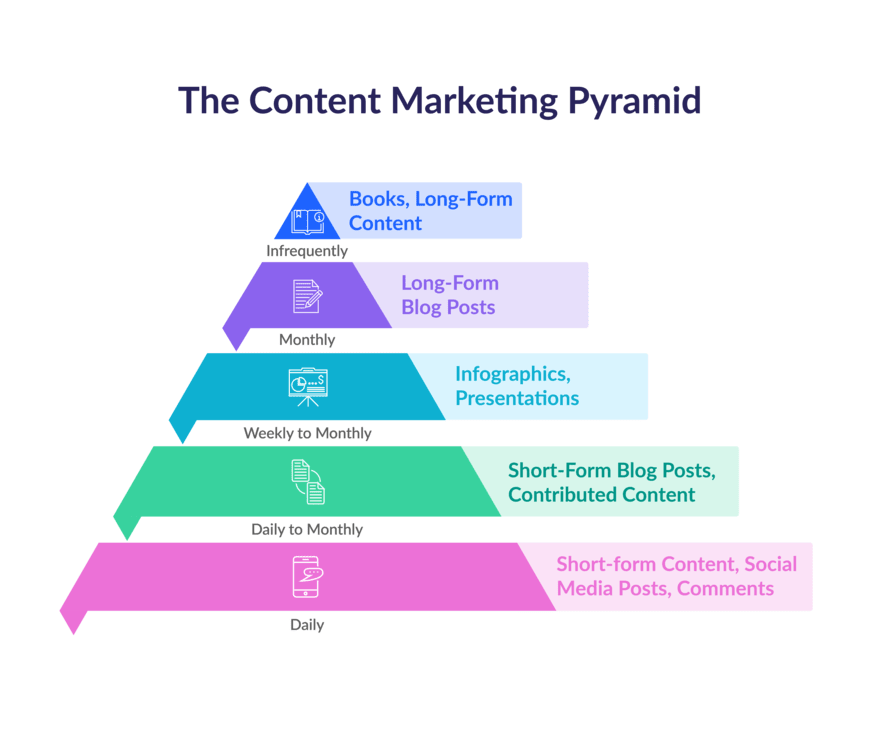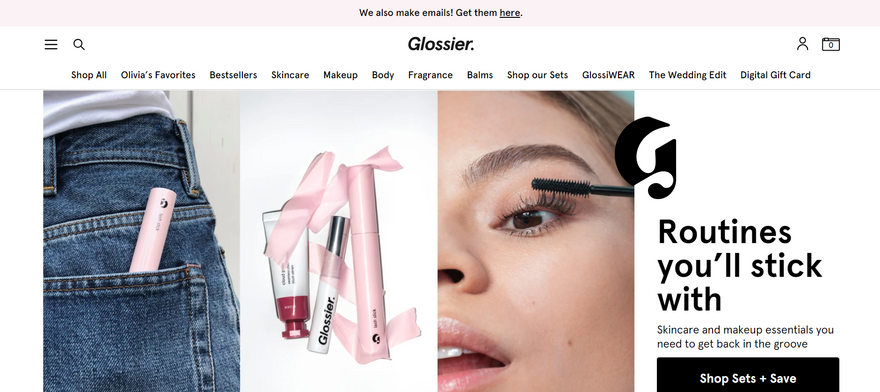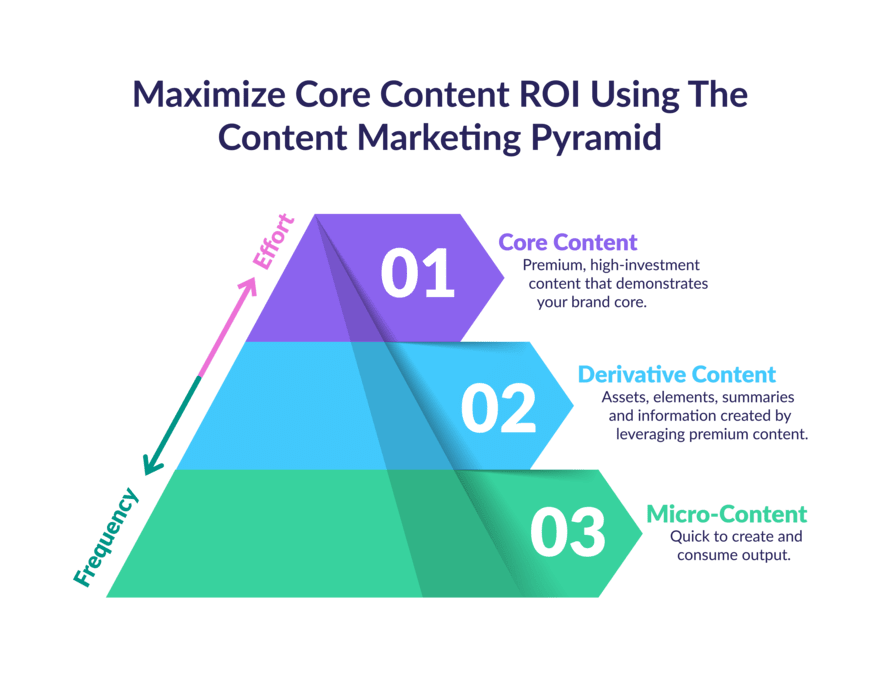Content Marketing Pyramid: The Ultimate Guide
If you click to purchase a product or service based on our independent recommendations and impartial reviews, we may receive a commission. Learn more
Producing high-quality content consistently can be overwhelming. We get it! But that’s where a content marketing pyramid comes in – a way to face the content demand head-on.
Having a framework like a pyramid in place coordinates your marketing efforts across different content types in order to make more effective use of your time and resources, and help you achieve your wider marketing goals.
But first, we’re going to talk about content marketing strategy because it’s really the first step in building a solid and stable content pyramid for your business.

Content Marketing Strategy: A Beginner's Guide
Content marketing pyramids fall under the umbrella of a content marketing strategy. If you think of the pyramid as the how, the strategy is the why. Let’s break it down.
Things To Remember:
- Content Marketing Strategy – Your overall strategy to achieve business goals, engage your target audience, and decide which content types to deliver and where.
- Content Strategy Framework – Within your content strategy you’ll have a framework in order to actually deliver your strategy. You can’t action your content strategy without having a framework in place. An example of a framework is a content marketing pyramid.
- Content Marketing Pyramid – This is a framework that splits content into five levels, from low-effort/frequent content to high-effort/rare content, and is designed to drive customer engagement from one level to the next until they convert.
A content marketing strategy is about producing and distributing relevant and targeted content for your audience. Having a detailed plan at the ready – of your goals and business aims – allows you to focus your efforts when creating content.
The ultimate objective is to effectively and efficiently boost customer engagement, increase sales, and drive traffic to your business.
How Does It Work?
A content marketing strategy is a key cog to have in place if you want the machine – your business – to run smoothly. Your content should speak to your target audience and market, so focusing on their pain points, queries, and desires will help you connect with them in an authentic way.
Basically, you don’t want to publish content blind! And if you have a pre-planned strategy to refer back to (with a framework for guidance such as the pyramid), then your content should be equipped to engage with your customers.
Ask yourself: who are you creating content for? What is the purpose of the content? What impact are you expecting or hoping for? When developing your strategy, you should identify your:
- Business goals – What do you want to achieve?
- Target audience – Who are you trying to reach?
- Content types – How do you want to share your message?
- Distribution plans – Where will you share your content?
- Content schedule – What deadlines can you hit realistically?
But why is a content marketing strategy so important? Put simply, it’s a well-tested method to help businesses compete in a market.
For example, posting frequently on social media can help drive community engagement, and having a blog is a great way to boost traffic organically. Whether you’re attracting new sales or setting your business up as the top customer choice, you need to deliver the right content at the right stage and to the right channel.
Having a content marketing pyramid to carry out that strategy is a great way to make sure your content is getting through to the target audience at each level, from pre-sales brand awareness through to purchase. We’ll go into more detail shortly!
The Benefits of a Content Marketing Strategy
Preparing your business with a content marketing strategy leaves you open to so many rewards and benefits. Of course, the strategy is created to help attract and retain loyal customers, but the process also solidifies your place in the market as an expert – a brand people will turn to when they’re looking for a specific product or service.
For example, having a strategy could help you:
- Attract new customers
- Engage with your community
- Strengthen brand loyalty
- Become an expert voice
- Drive brand awareness
- Increase organic traffic
- Boost revenue
- Improve SEO
When developing your strategy, you can experiment and figure out what works best for your business and target audience. The important thing is to remain consistent and stick to your strategy and framework so that you can continue to nurture the relationship between the customers and your business.
For your content strategy to succeed, you need a good range of content types to see results. Here are a couple of content strategy examples you could seek inspiration from:
1. GoPro

Video content is huge right now and GoPro proved that it’s a great way to engage with your audience and generate fresh content. Show off the product and provide examples of what kind of experiences users could have with it!
We recommend checking out our article on creating your own video marketing strategy if you want to know more.
2. Glossier

Make-up and skincare brand Glossier is well-known for its community-driven campaigns. A lot of its content is powered by users – from personal product photos to heartwarming success stories. User-generated content (UGC) is a great resource to tap into and helps boost social engagement because customers feel that the business genuinely cares about them.
But, having a solid ecommerce content marketing strategy is only the first step. What you really need is a content strategy framework to carry out the job.
What Is A Content Strategy Framework?
Although a content marketing strategy covers your overall goal, you need to build a content strategy framework if you want to deliver on those targets. You can’t have one without the other!
Everyone has dreams, but you need plans in place to achieve them.
Essentially, a content strategy framework is a tool to help you optimize your marketing efforts, and distribute sustainable and reusable content.
A content strategy encompasses your overall business goals within the marketing space, so that includes the types of content you want to use, where you want to share the content, and who you’re trying to target. A content strategy framework is there to help you deliver on your content strategy by creating valuable and sustainable content.
Remember, think of the strategy as the idea, and the framework as the plan. It should detail how your business will produce and share targeted content for different channels and audiences in order to reap the most rewards.
You’re not just churning out content for the sake of it! A framework gives your content more value – it has a purpose and set criteria to hit before being shared with the world.
Content Marketing Pyramid
The content pyramid structure simplifies the process of tackling your content needs by designating content to different levels.
In this digital age, you need to share content consistently and at a high-quality level if you want your business to survive. Using a content marketing pyramid to build your strategy framework gives you a chance to organize and coordinate all of your content marketing efforts so that you can carry out your overall content strategy successfully.
What we love most about using a pyramid is that through coordination of the various levels, your content develops a cohesive thread that allows you to push common themes across different content types and platforms.
Instead of relying on spontaneity or random creative urges, the content marketing pyramid removes risky decisions or wasteful content creation thanks to its streamlined structure.

The Pyramid Structure
A content marketing pyramid typically has five levels to it, representing different fields of content and effort. The peak of the structure focuses on high-effort and rare content, the foundation is made up of low-effort and very frequent content… and the middle three segments fill out the rest.
To give you an idea of the levels and content involved, take a look at this table:
| Pyramid Level | Effort Level | Content Examples |
|---|---|---|
| 1 - Top | High effort + infrequent Time-intensive research | Books, long-form content |
| 2 | Less effort than Level 1 Sharing sporadically (e.g. monthly) | Long-form blog posts |
| 3 | More effort than Level 4 Sharing often (e.g. weekly-monthly) | Infographics, presentations |
| 4 | Requires some effort Sharing regularly (e.g. daily-weekly) | Short-form blog posts |
| 5 - Bottom | Low effort + very frequent Sharing daily | Short-form content, social media posts, comments |
It’s important to have a good hybrid of content in your marketing strategy, from informative long-form to sales-led snappy content. Hook your readers in and then educate them about your business, and explain why your products or services are worth investing in.
Ultimately, you want content from the base of the pyramid to drive engagement up to the next level. Then rinse and repeat with each segment, until your audience reaches the summit of content and you close a sale.
Content Marketing Pyramid Benefits
The main benefit of a content marketing pyramid is that it supports your content strategy. Not only does it help you channel your energy into meeting focused goals and priorities, but it also provides you with a stable stream of content to use. Gone are the days of worrying about content ideas or struggling to fill a content schedule!
Here are six reasons why we love content marketing pyramids:
- Coordination – Ensure everyone is working towards the same goal and give your content a cohesive look
- Repetition – Drive home your dynamic messaging by reusing content to fit different formats and channels
- Consumability – Cater to everyone by using multiple content formats because readers like to absorb information in different ways
- Flexibility – The pyramid levels inspire a lot of content ideas from the bottom up or top down
- Balance – The pyramid makes it easy to strike a balance between content types
- Saturation – Reach a wider audience through earned and paid media channels
Build Your Own Pyramid
So, you want to build your own content marketing pyramid? It’s simple! But, it’s not something you can accomplish quickly so make sure you give yourself enough time to plan ahead and become completely familiar with your content strategy goals.
You should always be intentional about your content, and a content marketing pyramid can help you do just that. Use the set criteria on each level to guide your growth and work out a realistic content schedule for your business – you just need to make sure you’re reaching the appropriate audiences and diversifying your content formats.
The great thing about this style of framework is that you can take inspiration from the base content, or let material trickle down the levels from the top. For example, you could combine a series of social media posts to form a short-form blog post or take digestible chunks from long-form content to use elsewhere. Though the higher-level content provides a lot of material to springboard off, it’s easier to experiment within the bottom levels because they require less time to create and plan.
Advice from the Experts
Top Tip: If you want to create impactful content, listen to your audience. Your content should always focus on what they’re reacting to, whether that’s excitement for a product or frustrations they have with the brand.
Why Is A Framework Important?
As we’ve said already, a content strategy framework in the form of a pyramid can be hugely beneficial for businesses. It’s an important blueprint to have in place if you want to achieve the larger goals set out in your content marketing strategy. Not only does a framework clearly detail the steps needed to produce relevant content, but it should outline what tools, people, systems, and any other resources you would require.
If all of that doesn’t sell you, just think about the consequences of not having a framework. A content pyramid can help you avoid:
- Disruption
- A pyramid-style framework allows you to coordinate content and maintain good communication internally so you can avoid chaotic content
- Customer disengagement
- A framework ensures your messaging remains consistent and connects the relevant audience to the relevant content
- Waste
- One of the key benefits to having a content marketing pyramid is that it helps you repurpose content into new formats
Rather than tackle content creation unprepared, a content marketing pyramid is there to streamline your operation and make it as efficient and effective as possible.
Content Marketing Pyramid: Summary
To wrap up, a content marketing pyramid should help ease the process of implementing a content marketing strategy effectively. It can help you optimize and reuse your content for different channels, and coordinate your content needs ahead of time to avoid waste.
You want to make sure you’re sharing valuable content, touching on your expertise in the market, and fostering a strong bond between business and customer. Using the pyramid approach will guarantee that you’re set up for success in the long term, and we can’t wait to hear all about it!

Leave a comment